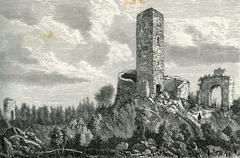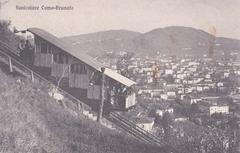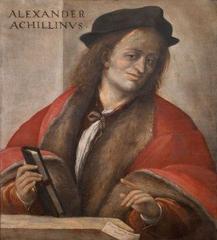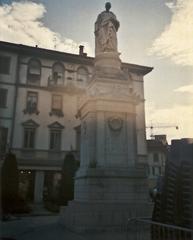
Como–Appiano Gentile–Mozzate Tramway: Visiting Hours, Tickets, and Historical Significance
Date: 04/07/2025
Introduction
The Como–Appiano Gentile–Mozzate tramway is a notable chapter in the transportation and cultural history of Lombardy, Italy. Established in the early 20th century, this metre-gauge electrified tramway connected Como with its southwestern suburbs and extended to Mozzate, a key railway junction on the Saronno–Varese–Laveno line. Conceived by the Società Anonima Trams Elettrici Comensi (SATEC) in 1907, the tramway embodied modernization, regional integration, and economic growth, enabling efficient movement for both people and goods (Museo Ferrovienord; it.wikipedia; wikiital.com).
From its opening in 1910 until closure in 1955, the tramway supported commuting, commerce, and social life, playing a vital role in the economic and cultural cohesion of the region. Despite its eventual replacement by road-based transport, its legacy endures through surviving infrastructure, museum exhibits, and local memory (fr.wikiital; OpenHistoricalMap). Today, visitors can explore remnants of the tramway, enjoy museum collections, and follow the historical route by bus, bike, or on foot (visitcomo.eu; ASF Autolinee C62 timetable).
Table of Contents
- Introduction
- Origins and Planning
- Construction and Technical Features
- Operational Years (1910–1955)
- Decline and Closure
- Legacy and Historical Significance
- Technical Details: Gauge, Electrification, Infrastructure
- Rolling Stock
- Route Structure and Operations
- Cultural and Regional Significance
- Visiting the Tramway Route: Hours, Tickets, and Tips
- Nearby Attractions
- Frequently Asked Questions (FAQs)
- Conclusion
- References
Origins and Planning
The tramway was conceived during a surge of modernization in northern Italy. In 1907, SATEC took responsibility for developing interurban tram lines to connect Como with its southwestern towns, notably Appiano Gentile and Mozzate. This initiative aimed to enhance economic integration and improve accessibility between urban and rural areas, reflecting the era’s faith in electrified transit (Museo Ferrovienord; it.wikipedia).
Construction and Technical Features
The Como–Appiano Gentile–Mozzate tramway was a single-track, metre-gauge (1,000 mm) line, electrified at 550 V DC through overhead wires (fr.wikiital). Construction used standard rails for most sections, with heavier Phoenix rails in high-traffic segments. The route extended approximately 24 kilometers, integrating urban street running in Como with dedicated rights-of-way through towns such as Veniano, Lurago, and Limido (it.wikipedia; fr.wikiital).
Operational Years (1910–1955)
The tramway commenced operation in 1910, rapidly becoming a lifeline for passengers and freight across the region (OpenHistoricalMap). It provided vital connectivity for residents, business, and commerce, with regular electric tram services managed by passing loops and careful scheduling. The link with Mozzate’s railway station enabled convenient transfers for longer journeys within the wider Lombardy rail network.
Decline and Closure
After World War II, the tramway faced growing competition from buses and private vehicles. Infrastructure aged, and maintenance became increasingly challenging for the operator, STECAV. By November 1955, tram service was replaced by buses; the urban tram section was transitioned to trolleybus operation, reflecting changing transportation priorities (it.wikipedia; fr.wikiital).
Legacy and Historical Significance
The tramway’s legacy is preserved in museum exhibits, road alignments, and community narratives. Its history is documented at institutions such as the Museo delle Ferrovie Nord and in photographic archives (Wikimedia Commons). The tramway is remembered as a symbol of regional development and early electrical engineering, with its path still influencing local infrastructure and urban planning (OpenHistoricalMap).
Technical Details: Track Gauge, Electrification, and Infrastructure
- Gauge: Metre gauge (1,000 mm), compatible with Como’s tram network
- Electrification: 550 V DC, overhead lines
- Infrastructure: Combination of street running and dedicated extraurban rights-of-way, with rails weighing 21.5–35.2 kg/m in various sections
- Network Length: Urban core of ~13.9 km, with extensions on extraurban lines (it.wikipedia)
Rolling Stock
The tramway operated with a fleet that evolved over time:
- Early Fleet: MAN-Siemens-Schuckert electric motor cars (38 units, delivered 1906–1913 and 1920–1922), around 8 meters in length
- Later Additions: TIBB motor cars added in 1927 (10 units), later upgraded for stability
- Liveries: Initially ivory white with gold lining, later changed to two-tone green for visibility
- Capacity: Typically seated 30–40 passengers with wooden benches and large windows (it.wikipedia)
Route Structure and Operations
Urban and Extraurban Connectivity
The tramway linked five main urban lines radiating from central Como with extraurban branches to Appiano Gentile and Mozzate, integrating city life with rural communities.
Key Routes
- Como–Appiano Gentile–Mozzate: The primary extraurban line
- Urban Core: Included routes from San Giovanni railway station to the funicular and from Piazza Cavour to Ponte Chiasso (Swiss border)
Service Frequency
- Urban: Every 10–15 minutes at peak
- Extraurban: Every 30–60 minutes, coordinated for seamless transfers
Cultural and Regional Significance
The tramway’s establishment was pivotal in stimulating local economies, supporting population growth, and integrating urban and rural areas (wikiital.com; understandingitaly.com). Its role in daily life included facilitating access to markets, festivals, and work, as well as distributing regional products like cheese and polenta. The tramway’s electrified system reflected Lombardy’s innovative spirit, echoing Como’s connection to Alessandro Volta.
Visiting the Tramway Route: Hours, Tickets, and Tips
Museums and Historic Sites
- Museo delle Ferrovie Nord: Open Tuesday–Sunday, typically 9:00 AM–5:00 PM. Check official schedules for updates.
- Como Transport Museum: Features tramway exhibits and vintage vehicles (visitcomo.eu).
Exploring the Route
- Public Transport: The ASF Autolinee C62 bus line closely follows the former tramway route, operating daily (approx. 6:00 AM–9:00 PM) (ASF Autolinee C62 timetable).
- Tickets: Single-ride tickets cost about €1.50–2.00, available at bus stations, shops, online, and via mobile apps.
- Accessibility: Most museums and buses are wheelchair accessible; some rural walking/cycling paths may be less accessible.
Travel Tips
- Combine tramway exploration with visits to nearby attractions such as Como Cathedral, Lake Como, and the funicular.
- Local bike rentals in Como and Mozzate enable cycling along the historic route.
- Engage with local historical societies or municipal offices for occasional exhibitions or guided walks.
Nearby Attractions
- Como Cathedral (Duomo di Como): Iconic gothic structure in the city center
- Lake Como: Promenades, historic villas, and gardens
- Appiano Gentile: Historic town centers, markets, and seasonal festivals
- Cultural Events: Check Lake Como’s cultural events calendar
Frequently Asked Questions (FAQs)
Q: Is the Como–Appiano Gentile–Mozzate tramway still operational?
A: No, it closed in 1955. The route is now served by bus and some trolleybus services.
Q: Where can I see remnants of the tramway today?
A: Remnants are visible in Appiano Gentile, Mozzate, and along rural paths and road alignments. Some original stations have been repurposed.
Q: Are there guided tours or exhibitions?
A: Occasionally, local museums and societies offer guided walks and exhibitions. Check municipal websites for current offerings.
Q: What are the visiting hours and how do I buy tickets?
A: Museums are generally open daytime hours with ticket sales on-site or online. Bus tickets for the C62 line can be purchased at stations and via mobile apps.
Q: Is the route accessible for visitors with disabilities?
A: Buses and most museums are accessible; some outdoor sections may be less so.
Conclusion
The Como–Appiano Gentile–Mozzate tramway is a vivid testament to the spirit of innovation and regional unity that shaped Lombardy in the early 20th century. Although decommissioned, its influence persists in the urban landscape, local memory, and cultural heritage. Visitors can engage with its legacy through museum exhibits, following the historic route, or joining local tours. Make the most of your visit by leveraging digital resources like the Audiala app and consulting up-to-date information from official tourism portals.
References and Further Reading
- Museo Ferrovienord – Industry Sidings / Mozzate Tramway (Museo Ferrovienord)
- Tranvia Como-Appiano Gentile-Mozzate (it.wikipedia)
- Rete tranviaria di Como (it.wikipedia)
- Tranvia Como-Appiano Gentile-Mozzate (wikiital.com)
- Como–Appiano Gentile–Mozzate tramway history (OpenHistoricalMap)
- ASF Autolinee C62 Timetable (ASF Autolinee C62 timetable)
- Como Transport Museum (visitcomo.eu)
- Cultural Events on Lake Como in 2025 (lagodicomo.com)
- Understanding Italy: Como Province (understandingitaly.com)
- Wikimedia Commons: Como–Appiano Gentile–Mozzate tramway (Wikimedia Commons)
All external links open in a new tab for your convenience.









